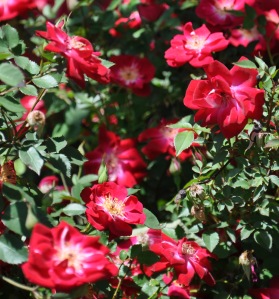Our climate is hot and humid enough that the roses I've planted succumb to black spot pretty quickly. It doesn't help that I expect them to make it without a lot of help from me. The one exception is a miniature rose that I got years ago because it was so cute in it's little pot. It was supposed to be a house plants but it wasn't long before it looked pitiful and I stuck it in the ground out front and told it to sink or swim. It swam.
The dark bush covered with red flowers is my former 'miniature' rose. I did try to remove it once… which only made it spread more. Every now and then I whack it back, knowing that it will come back with a vengeance. I've decided to love it, which is pretty easy to do this time of year.














